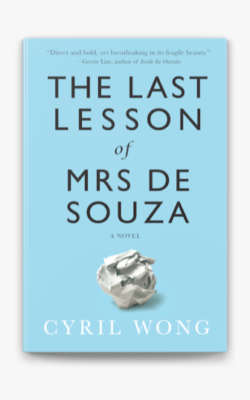The Last Lesson of Mrs De Souza Review

When we talk about Singlit (local literature), we look at works that reference or reflect what is uniquely Singapore. These distinctive experiences and perspectives are special to us, and are pretty much unreplicable. Other than simply having HDB buildings as backdrops in a story, or mentioning the striking names of MRT stations, some works in Singlit go beyond exploring our lifestyle. Books like The Last Lesson of Mrs De Souza touch on stories of censorship, our repressed culture, and perhaps its consequences on some of our beliefs and actions. But does this uniquely Singaporean viewpoint always bring about more enjoyment or relatability?
The Last Lesson of Mrs De Souza follows the main character, Mrs De Souza, and her last day as a teacher. Here she traces a tale of a past student, a young boy named Amir. Without giving away too much, Mrs De Souza asserts that Amir’s story has greatly impacted her life, as she recounts it in first-person narration. (though readers would probably agree that her actions were what greatly impacted Amir’s life, much more).
As aforementioned, the story touches on issues such as censorship. While the first-person narration clearly outlines the impacts of a repressed state on individuals like Amir, embedded in her words and actions are these very (conservative) beliefs; the self-righteousness and lack of remorse of Mrs De Souza also display the grave consequences of these qualities. The main plot then hedges on the conflicts that arise within an individual, between them and society, when narrow outlooks serve as blinkers that hinder vision.
The Elephant in the Room
Whether you have or haven’t read the book, it is probably clear that Mrs De Souza is not exactly likeable. While main characters are typically heroic, or at least understandably flawed, the bulk of this book’s readers remark that Mrs De Souza was simply too disturbing. Paired with the novel’s first-person narrative style, the heroine (or antiheroine) and her untethered mentally was revolting to many.
Beyond that, Mrs De Souza remains rather unknowable. Her character was written in an intricate manner where you delve into her psyche — her dreams, her daydreams, and at times her consciousness — but you barely know her; You know the version of her in her own words. As readers we unpack her character through her narrative, her actions that we believe as half-truths, and her recollections that meld together with her dreams that are peppered throughout the story.
Though I do not exactly empathise with her, I fail to agree wholeheartedly with reviews online that say she was completely guilt free regarding her actions. To me, the very unreliable narration not only showcases who this woman is (frankly, self-righteous and slightly self-obsessed), but also how the incidents in her life have affected her and her thoughts. Her words, then, reveal less about the incidents themselves, but her reactions to them (such as her ‘wandering mind’ on page 139), which I believe are much more open-ended.
On page 208, one of my favourite segments of the book reveals much of Mrs De Souza. As she converses with her husband, Christopher, she laments that “It’s as if Amir was, in the end, just another statistic,” and “Just another boy’s name in the school register.” Here, Christopher responds with “But Rose, you almost forgot him too, remember?”
I particularly enjoyed the build up of Mrs De Souza’s thoughts about the story (and Amir), before her complaint to Christopher. To me, Christopher’s innocent response paints his wife’s character nicely, how she is part of the problem and how she does not see it that way.

Ends of the Spectrum
Having such an unreliable and unlikeable narrator creates a spectrum of opinions; Some of the readers truly enjoyed the novel as it is, loving her interesting characterisation, while others wished she was at least a bit more relatable and realistic. I could see how suffocating and uncomfortable her self-absorption would make some readers feel, especially when the narration swiftly transitions from grave, painful topics such as death, to narcissistic descriptions of a vain subject matter.
Also, some readers may feel that temporal tos-and-fros are not exactly their thing, as the storyline appears straightforward, while the narration is not. For me, jumping from reality to dream world adds value to the story and Mrs De Souza’s characterisation (as they reflect her psyche and thoughts), while raising questions about the veracity of her real world. However, I understand that a non-linear story may not be as enjoyable for everyone. Additionally, the lack of a clear linear narrative structure (the trusty Fretytag’s Pyramid we are familiar with) could be off putting to many; where there is no conclusion, some may feel lost at the end of the story. However, if you enjoy open-ended conclusions, or simply the lack of a conclusion, then the novel could be for you.
Lastly, I felt that the form of narration, how subject matters that engender emotion (like death) are downplayed, or how complex issues are brushed off, is intentional. While it was disturbing and uncomfortable, I could not bring myself to stop reading her perspective. Wearing Mrs De Souza’s lens, these grave accounts are in turn simplified, like they were in her mind, as if they were just another statistic.
Conclusion, if any
These two ends of the spectrum then lead up to the question of whether you should read this novel. I am unsure if my personal bias towards Singlit contributes to my liking of this book. However, if you are looking to acquaint yourself with Singlit, or explore more books with painfully unreliable narration, The Last Lesson of Mrs De Souza could be a suitable book to pick up from Epigram, BooksActually, or in libraries near you. All in all, I enjoyed the book and hope that if you read it, some parts of it will stick with you too.
By: Shannon Ling
Director, Editorial, ReadNUS
